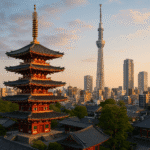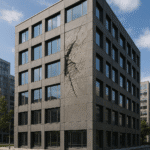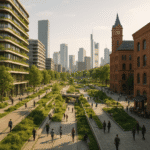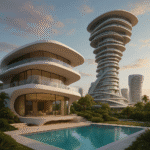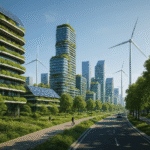Urban farming in high-rises represents a groundbreaking shift in architectural design, merging sustainability with modern living. As cities continue to expand and populations grow, the need for innovative solutions to food production and resource management becomes increasingly critical. This article explores the concept of self-sustaining buildings, where urban farming is integrated into high-rise structures, offering a glimpse into the future of urban living.
The Rise of Urban Farming in Architecture
The integration of urban farming into architectural design is not merely a trend but a necessary evolution in response to global challenges. As urban areas become more densely populated, the demand for fresh produce and sustainable living solutions intensifies. Urban farming in high-rises addresses these needs by transforming buildings into vertical ecosystems capable of producing food, recycling waste, and conserving energy.
One of the primary drivers behind this movement is the increasing awareness of environmental issues and the need for sustainable development. Traditional agriculture requires vast amounts of land and resources, often leading to deforestation and habitat destruction. By contrast, urban farming in high-rises utilizes vertical space, reducing the ecological footprint and preserving natural landscapes.
Architects and urban planners are now tasked with designing buildings that not only serve as living or working spaces but also contribute to the local food supply. This involves incorporating advanced technologies such as hydroponics, aquaponics, and aeroponics, which allow for efficient food production without soil. These systems use significantly less water than traditional farming methods and can be integrated into the building’s infrastructure, creating a closed-loop system that minimizes waste.
Technological Innovations and Design Challenges
The successful implementation of urban farming in high-rises relies heavily on technological innovations. One of the most promising technologies is hydroponics, a method of growing plants without soil by using mineral nutrient solutions in a water solvent. This technique is particularly suited for high-rise buildings, as it allows for the cultivation of crops in controlled environments, optimizing growth conditions and maximizing yield.
Aquaponics, a system that combines aquaculture (raising fish) with hydroponics, is another innovative approach gaining traction. In this system, fish waste provides an organic nutrient source for the plants, while the plants help to filter and clean the water for the fish. This symbiotic relationship creates a sustainable cycle that can be maintained within the confines of a high-rise building.
Despite the potential benefits, integrating urban farming into high-rise architecture presents several design challenges. One of the primary concerns is ensuring adequate light for plant growth. Architects must design buildings that maximize natural light exposure or incorporate artificial lighting systems that mimic sunlight. Additionally, the structural integrity of the building must be considered, as the added weight of soil, water, and plants can impact the overall stability.
Another challenge is the integration of these systems into existing urban infrastructure. Retrofitting older buildings with urban farming capabilities can be costly and complex, requiring significant modifications to plumbing, electrical, and structural systems. However, as technology advances and the demand for sustainable solutions grows, these challenges are becoming more manageable.
Case Studies: Pioneering Projects in Urban Farming
Several pioneering projects around the world are showcasing the potential of urban farming in high-rises. One notable example is the Bosco Verticale in Milan, Italy. This pair of residential towers is adorned with over 900 trees and 5,000 shrubs, creating a vertical forest that not only produces oxygen but also provides insulation and reduces noise pollution. The Bosco Verticale serves as a model for integrating greenery into urban environments, demonstrating the aesthetic and environmental benefits of such designs.
In Singapore, the Oasia Hotel Downtown is another example of innovative urban farming architecture. The building features a lush vertical garden that covers its façade, providing natural cooling and reducing the need for air conditioning. The hotel also incorporates sky gardens and open-air terraces, creating a seamless connection between the built environment and nature.
These projects highlight the potential for urban farming in high-rises to transform cityscapes, offering sustainable solutions to urban challenges while enhancing the quality of life for residents. As more cities adopt these practices, the future of urban living will likely be characterized by buildings that are not only self-sustaining but also harmonious with the natural environment.
The Future of Self-Sustaining Buildings
As the concept of urban farming in high-rises continues to evolve, the future of self-sustaining buildings looks promising. These structures have the potential to revolutionize urban living by providing fresh produce, reducing carbon footprints, and promoting a healthier lifestyle. Moreover, they offer a solution to food security issues, particularly in densely populated areas where access to fresh produce is limited.
In the coming years, we can expect to see more cities embracing this approach, driven by advancements in technology and a growing commitment to sustainability. Governments and private developers will play a crucial role in supporting these initiatives, providing incentives and funding for research and development.
Furthermore, the integration of smart technologies will enhance the efficiency and effectiveness of urban farming systems. Sensors and data analytics can monitor plant health, optimize resource use, and predict crop yields, ensuring that these systems operate at peak performance. This will not only improve the viability of urban farming in high-rises but also make it more accessible to a wider range of communities.
In conclusion, urban farming in high-rises represents a significant step forward in the quest for sustainable urban development. By reimagining the role of buildings in our cities, we can create environments that are not only self-sustaining but also resilient and adaptable to the challenges of the future. As we continue to innovate and push the boundaries of architectural design, the dream of self-sustaining cities may soon become a reality.
